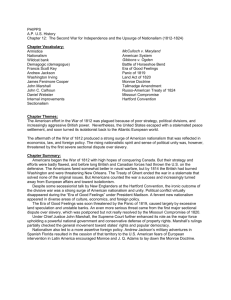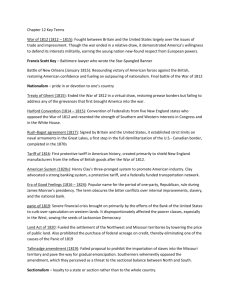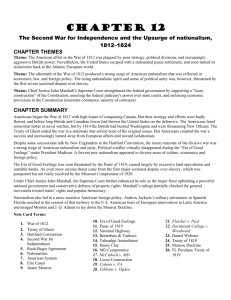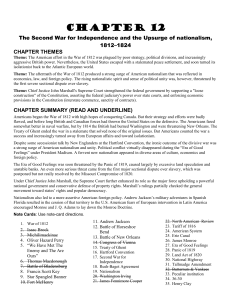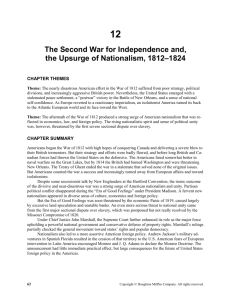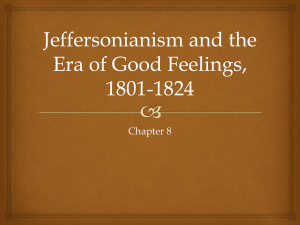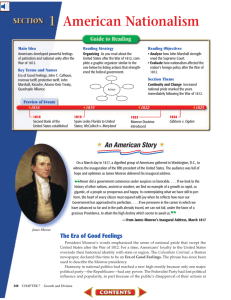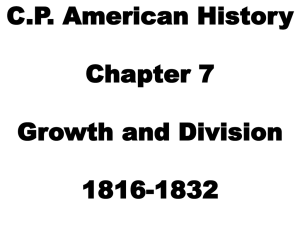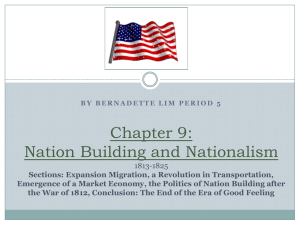APUS Unit 4 Ch.12 PPT
advertisement
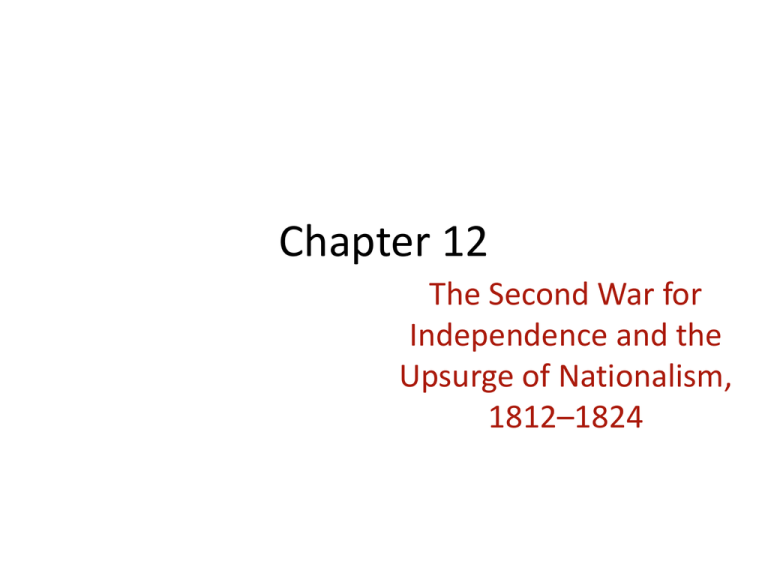
Chapter 12 The Second War for Independence and the Upsurge of Nationalism, 1812–1824 Themes • The American effort in the War of 1812 was plagued by poor strategy, political divisions, and increasingly aggressive British power. Nevertheless, the United States escaped with a stalemated peace settlement and soon turned its isolationist back to the Atlantic European world. • The aftermath of the War of 1812 produced a strong surge of American nationalism that was reflected in economics, law, and foreign policy. The rising nationalistic spirit and sense of political unity was, however, threatened by the first severe sectional dispute over slavery. • Chief Justice John Marshall’s Supreme Court strengthened the federal government by supporting a loose construction of the Constitution, asserting the federal judiciary’s power over state courts, and enforcing economic provisions in the Constitution (interstate commerce, sanctity of contracts). Causes of the War of 1812 • British impressment • British Orders in Council • American desire to wipe out Indian threat in West and eliminate Canada as a sanctuary • Republican belief that war would restore confidence in American democratic experiment Major Battles • Canada • - British repulsed American invasion of Canada • - U.S. won naval battles on Lake Erie and Lake Champlain • Washington D.C. burned (1814) • Baltimore defended (Fort McHenry) • Battle of New Orleans (1815)- American forces led by Andrew Jackson defeated British p225 Map 12-1 p226 p227 Federalist Grievances and the Hartford Convention p228 Map 12-2 p229 The Second War for American Independence Results of the War • • • • U.S. gained new respect Sectionalism was weakened (temporarily) Federalists ceased to be an effective party Andrew Jackson and William Henry Harrison emerged as war heroes • U.S. manufacturing prospered • increased nationalism (spirit of national consciousness or national oneness) p230 Nascent Nationalism Nationalism- loyalty and devotion to a nation; a sense of national consciousness In what ways do we see evidence of American nationalism today? Was America more or less unified after the War of 1812 than before it? Nationalism after the War of 1812 • One result of the War of 1812 was a new sense of nationalism • Examples – – – – – – – National literature School textbooks Painters Renewed Bank of the U.S. Larger army Rebuilt national capital in D.C. Manufacturing (and protectionism) p232 Tariff of 1816 • First tariff in American history instituted primarily for protection, not revenue • 20-25% rates • Beginning of a protectionist trend “The American System” • Plan by Henry Clay for developing a profitable home market • Three parts – A strong banking system which would provide easy credit – A protective tariff – A network of road and canals in the Ohio Valley funded by the proceeds from the tariff • Foodstuffs and raw materials from the South and West would go to the North and East • Manufactured goods would go to the South and West • The country would be tied together economically and politically p231 Opposition to internal improvements • Madison vetoed a bill by Congress to fund internal improvements as unconstitutional -(Republicans returned to strict constructionism on this issue) • New England also opposed federally constructed roads and canals since this would lead to new states in the west Election of 1816 • Republican James Monroe (DemocraticRepublican) defeated Rufus King (Federalist) The So-Called Era of Good Feelings In what ways was the ‘Era of Good Feelings’ an appropriate name for the period after the War of 1812, and in what ways was it inappropriate? Underlying Issues • • • • • • The tariff The bank Internal Improvements The sale of public lands Sectionalism Slavery p233 The Panic of 1819 and the Curse of Hard Times • A significant cause was overspeculation in frontier lands (The Bank of the U.S. through its western branches had played a role in this) • The Bank of the U.S. eventually forced the “wildcat” banks to foreclose mortgages on many farms – Resulted in western debtor distrust of the Bank of the U.S. • Political and social repercussions Growing Pains of the West Technology and internal improvements • The Cumberland Road (begun 1811) from Maryland to Illinois • The use of the steamboat on western waters (1811) • The Erie Canal (1825) Slavery and the Sectional Balance • In 1788 the North and South were comparable in terms of wealth and population • Over time, the North grew wealthier and more populous • Balance was maintained in the Senate • Missouri’s request for admission as a slave state upset this delicate balance – House of Representatives tried to pass the Tallmadge amendment which would have prevented more slaves from being brought into Missouri and would have provided for gradual emancipation • South was upset with the amendment fearing it could set a precedent for other territory west of the Mississippi and that it might even represent the beginning of Congressional efforts to abolish slavery • The issue of slavery was political and economic although a small group of antislavery advocates increasingly raised it as a moral issue p234 The Missouri Compromise • 1820 • Led by Henry Clay, Congress found a compromise • Missouri admitted as a slave state • Maine admitted as a free state • Slavery prohibited north of the 36 30’ line Map 12-3 p235 Thomas Jefferson to John Holmes • “this momentous question, like a fire bell in the night, awakened and filled me with terror.” – http://www.loc.gov/exhibits/jefferson/159.html • “I take it for granted that the present question is a mere preamble- a title page to a great tragic volume.” –John Quincy Adams p236 p237 John Marshall and Judicial Nationalism • The Supreme Court under John Marshall strengthened the power of the federal government McCulloch v. Maryland (1819) • Maryland tried to destroy a branch of the Bank of the U.S. by taxing its notes • The Supreme Court ruled the bank constitutional by invoking the doctrine of implied powers • Marshall denied the power of Maryland to tax the bank • “the power to tax is the power to destroy.” Significance • Strengthened the concept of loose construction • The Constitution derived from the consent of the people and thus permitted the gov’t to act for their benefit • It was intended to endure and therefore could adapt to new circumstances • “Let the end be legitimate, let it be within the scope of the Constitution, and all means which are appropriate, which are plainly adapted to that end, which are not prohibited, but consist with the letter and spirit of the Constitution, are constitutional.” –John Marshall Cohens v. Virginia (1821) • The Cohens brothers were convicted in Virginia of illegally selling lottery tickets • Marshall and the Supreme Court upheld the conviction • Established the principle that the Supreme Court could review a state court’s decision involving any of the powers of the federal government Gibbons v. Ogden (1824) • New York attempted to grant a monopoly to a steamboat company that operated between New York and New Jersey • The Supreme Court ruled that Congress alone had the power to regulate interstate commerce (Article I, Sec. VIII) Judicial Dikes Against Democratic Excesses • Marshall and the Supreme Court also issued a series of decisions that affirmed protections for property rights Fletcher v. Peck (1810) • The Supreme Court ruled that a state could not invalidate a contract • The first time the Court declared a state law to be unconstitutional Dartmouth College v. Woodward (1819) • New Hampshire had tried to change Dartmouth from a privately chartered college into a public institution • The Supreme Court ruled that the original charter should remain because it was a contract, and the Constitution protected contracts from state encroachment • At the same time that the nation was moving in the direction of greater popular sovereignty and control (especially at the state level), Marshall reaffirmed the power of the federal government and helped to create a stable environment for business along more conservative, centralized lines p239 Sharing Oregon and Acquiring Florida • President Monroe and Secretary of State John Quincy Adams were both staunch nationalists in terms of foreign policy • Treaty of 1818 – Americans were permitted to share the Newfoundland fisheries with Canada – Northern boundary of the Louisiana territory was established at the 49th parallel – Oregon territory was to be jointly occupied for 10 years • During War of 1812, Americans seized western Florida • 1818 Andrew Jackson moved into Florida using as an excuse the presence of hostile Seminole Indians and runaway slaves • Florida Purchase Treaty of 1819 – Spain ceded Florida and Spanish claims to Oregon in exchange for America abandoning claims to Texas Map 12-4 p240 Map 12-5 p240 p241 The Menace of Monarchy in America • Fear existed that European monarchies (Russia, Austria, Prussia, and France) would try to crush the newly free colonies in Latin America • 1823 Britain wanted to join with America in warning European monarchies to keep out of Latin America – Britain wanted to maintain its newly opened trade with the Latin American republics p242 The Monroe Doctrine • 1823 • In his annual message to Congress, Monroe warned the European powers against intervention in the Western Hemisphere • Two basic features – Non-colonization – Non-intervention Monroe’s Doctrine Appraised • The doctrine had little practical significance at the time • It was an expression of America’s post-1812 nationalist spirit • The U.S. did not have the military power to back it up (the British navy was, in fact, what stood between the Americas and the European powers) • “While giving voice to a spirit of patriotism, it simultaneously deepened the illusion of isolationism. (Pageant, p.255)” Map 12-6 p243 p245
